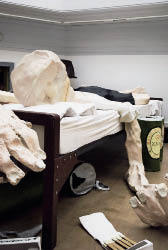The Saatchi Gallery at Ipswich Art School
1 Upper High Street, Ipswich, until 9 January 2011, Tuesday to Sunday, 10–5
The town of Ipswich is not known for its art. It has a museum and various art galleries, but it is perhaps more celebrated as a port, as the birthplace of Cardinal Wolsey and the home of the cartoonist Carl Giles. It has some beautiful old buildings — examples of exquisite pargeting can still be seen in Butter Market in the town centre — evidence that Ipswich was in the 16th century one of the richest towns in England. Now it has one of Norman Foster’s first important buildings: the headquarters of marine insurers Willis, a darkly dramatic reflective glass structure built in 1975, and Grade 1 listed. Today the port seems curiously disconnected from the town itself (you almost wouldn’t know it was there) and the various amenities are scattered between roundabouts without real focus. Ipswich is a town in search of an identity.
One new initiative aims to unite and augment the presence of the visual arts in Ipswich, centred upon the Museum and the neighbouring former Art School in the High Street. At once an anomaly arises, for their location may be the High Street, but it is in fact several minutes’ walk away from what is now the main drag of the town. Nevertheless, this slightly isolated position on the hill can be turned to advantage, for here a redevelopment may proceed without too much commercial competition. Walking up the High Street, the visitor first encounters a handsome brick building running back from the road labelled High Street Exhibition Gallery, currently used as a store but all set to be reclaimed as a gallery. Then comes the red-brick Victorian Museum, built in 1881 to replace the original building in Museum Street, one of the first local authority museums in Britain. Then to the north is a 1930s annexe, which until quite recently was Ipswich Art School.
In November 2000, I wrote an article in The Spectator about the demise of Ipswich Art School, despite the fact that Maggi Hambling had publicly attacked the decision to teach art in ‘two carpeted rooms’ and no longer in a building made for the purpose. Sadly, Hambling’s stand had no effect, but now plans are afoot to buy the property and make it integral to a new visual-arts complex based around the Museum. And the current owner, Suffolk New College, is allowing Ipswich Council to borrow the space and use it as an art gallery for the next two years while it raises the necessary purchase funds.
The first exhibition in the temporary space is a selection of sculpture from the Saatchi Gallery in London. This is not top-flight Saatchi — none of your Damiens or Traceys — but a considered selection of youngish artists who make very temporary-looking objects with an immediate impact. The centrepiece is a vast papier-mâché giant sprawled on a great bed surrounded by the detritus of modern junk living: crisp packets, fag ends, beer cans, car keys and slippers. The bed is also a stage, and the artist is the former playwright Will Ryman (born 1969), son of the noted American minimalist Robert Ryman. Drama is the keynote, as it is for the supersized pair of boots made from liquorice by Andy Yoder shown in a side gallery.
The real star of the exhibition is the building itself, centred around the wonderful light-filled octagonal atrium. Smaller rooms radiate out on two floors from this hub, offering considerable flexibility as exhibition space. Upstairs, the awed visitor can more fully appreciate the splendours of the atrium and get a better view (should that be required) of the ‘art’ downstairs. Among the artists on show up here are Alexandra Bircken (born 1967), who has made a sculpture-like layer cake from polyurethane foam, and Francis Upritchard (born 1976), who offers a nightmarish sloth-like creature of fake fur, kid gloves and rings.
Part of the future plan for the gallery is to focus on artists who have worked in the area and drawn inspiration from it. Five minutes’ walk away is Christchurch Mansion, a beautiful house set in parkland which is another museum, containing such treasures as the 16th-century Hawstead Panels, a rare series of domestic paintings by a highly talented amateur, and important examples of the work of the two greatest Suffolk artists, Gainsborough and Constable. So, the historical is covered by Christchurch Mansion, leaving the modern and contemporary to the High Street. In particular, there will be an emphasis on the East Anglian School of Painting and Drawing, run by Cedric Morris and Lett Haines, with such friends and satellite figures as John Nash, John O’Connor and John Skeaping. Apart from Lucian Freud, the school’s best-known student is Maggi Hambling.
Local hero Hambling has been adopted as figurehead for the scheme to bring art to Ipswich. She seems quite happy to be cast in this role, provided that it doesn’t interfere too much with her own work. ‘The restoration of Ipswich Art School as a place of vision,’ she says, ‘could refocus attention on the vital richness of the area and its continuing inspiration for artists. It is essential that the project’s main ambition is to be a centre of excellence rather than following the dictates of fashion. If this is achieved, real success will surely follow.’ Let us hope that the good people of Suffolk and the many artists in the region will rally to this new resource.






Comments